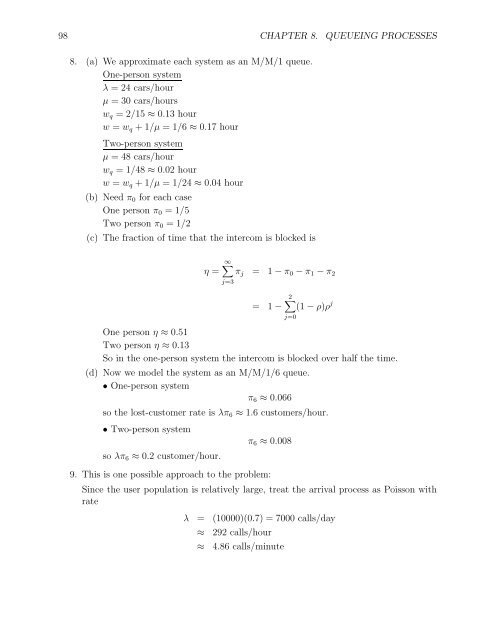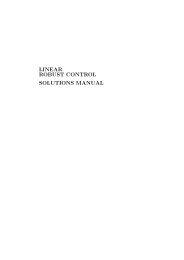SOLUTIONS MANUAL for Stochastic Modeling: Analysis and ...
SOLUTIONS MANUAL for Stochastic Modeling: Analysis and ...
SOLUTIONS MANUAL for Stochastic Modeling: Analysis and ...
You also want an ePaper? Increase the reach of your titles
YUMPU automatically turns print PDFs into web optimized ePapers that Google loves.
98 CHAPTER 8. QUEUEING PROCESSES<br />
8. (a) We approximate each system as an M/M/1 queue.<br />
One-person system<br />
λ = 24 cars/hour<br />
µ = 30 cars/hours<br />
w q =2/15 ≈ 0.13 hour<br />
w = w q +1/µ =1/6 ≈ 0.17 hour<br />
Two-person system<br />
µ = 48 cars/hour<br />
w q =1/48 ≈ 0.02 hour<br />
w = w q +1/µ =1/24 ≈ 0.04 hour<br />
(b) Need π 0 <strong>for</strong> each case<br />
One person π 0 =1/5<br />
Two person π 0 =1/2<br />
(c) The fraction of time that the intercom is blocked is<br />
∞∑<br />
η = π j = 1− π 0 − π 1 − π 2<br />
j=3<br />
2∑<br />
= 1− (1 − ρ)ρ j<br />
j=0<br />
One person η ≈ 0.51<br />
Two person η ≈ 0.13<br />
So in the one-person system the intercom is blocked over half the time.<br />
(d) Now we model the system as an M/M/1/6 queue.<br />
• One-person system<br />
π 6 ≈ 0.066<br />
so the lost-customer rate is λπ 6 ≈ 1.6 customers/hour.<br />
• Two-person system<br />
π 6 ≈ 0.008<br />
so λπ 6 ≈ 0.2 customer/hour.<br />
9. This is one possible approach to the problem:<br />
Since the user population is relatively large, treat the arrival process as Poisson with<br />
rate<br />
λ = (10000)(0.7) = 7000 calls/day<br />
≈ 292 calls/hour<br />
≈ 4.86 calls/minute















